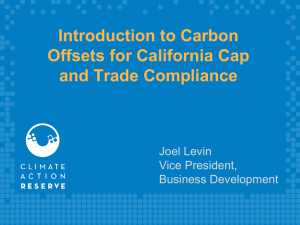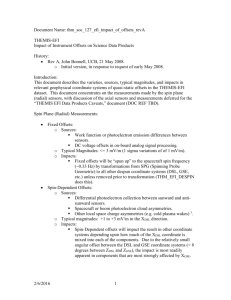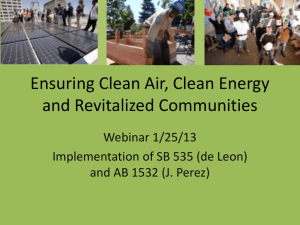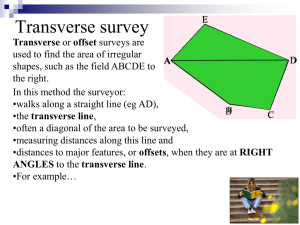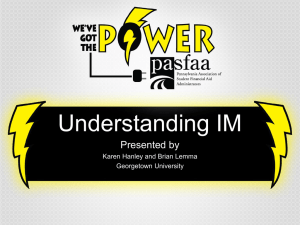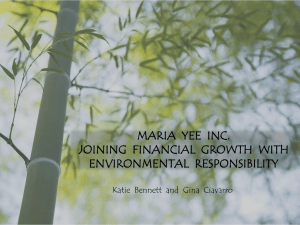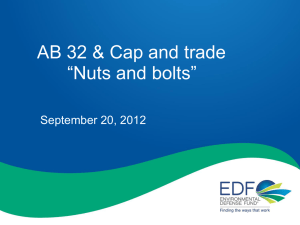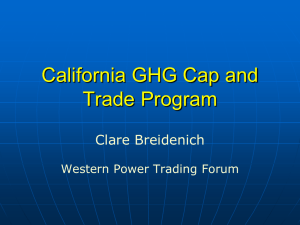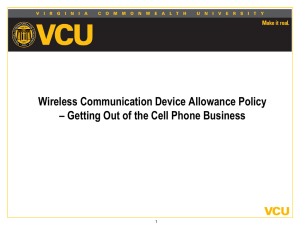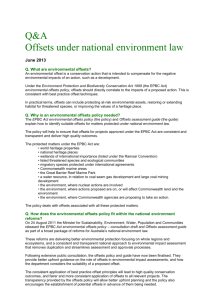CARB Approved Offsets - Climate Action Reserve
advertisement
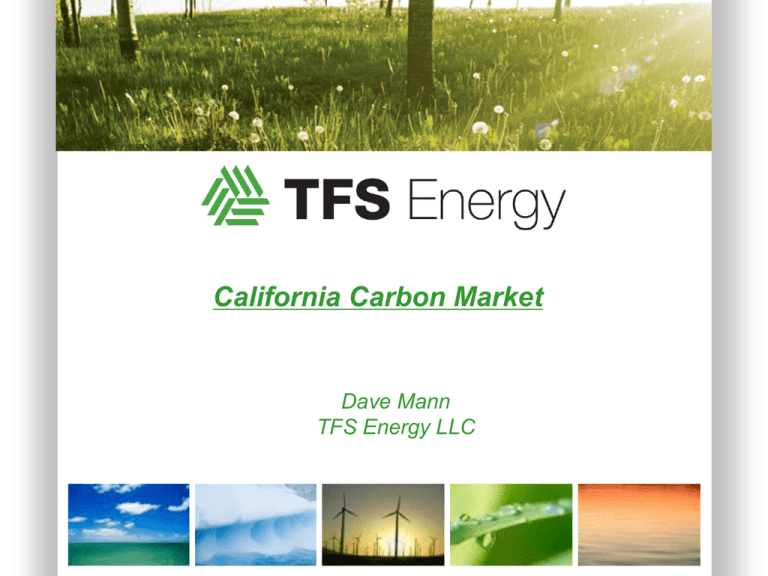
California Carbon Market Dave Mann TFS Energy LLC AGENDA Introduction to TFS Energy California Carbon Market Regulatory Update Market Instruments Pricing Update Hedging Structures Going Forward Conclusion TFS Energy – Introduction Who We Are and What We Do Subsidiary of Tradition (www.Tradition.com) Over 2,500 global employees Operations in 18 countries 200 energy experts - 10 energy offices worldwide Environmental products focused in New York and London 12 years in environmental markets / 10 years in greenhouse gas Environmental team is diverse group of experience financial market professionals, lawyers and accountants Specialize in introductory services in all energy and environmental commodities TFS Energy – Introduction Industry leading EU-ETS and CER desk in London and New York Unrivaled knowledge of opportunities and risk based on our experience in the world’s largest GHG market since its inception Strong understanding of pricing relationships between allowances, primary and secondary market offsets Long term relationships with project developers, financial institutions and multi-national industrial concerns who will be active in the California market. As well as existing relationships with domestic utilities, merchant energy producers, refiners and industrials from other US environmental markets that will be affected by AB32 TFS Energy – Introduction Recognized by industry-leading publications as “best in class” Point Carbon 2010 – “Best Broker” Environmental Finance 2010 – “Deal of the Year” Mexico City CFL swap with CERs going to Dutch Utility Environmental Finance 2009 – Best Primary Originator for GHG Emissions Kyoto Projects Credits Energy Risk 2009 – “Best Broker; US VERs” Numerous other awards from both Environmental Finance and Energy Risk for other US based environmental markets including – RECs, NOx, SO2, RTCs and ERCs Regulatory Update CARB has appealed to the March 18 Superior Court ruling in favor of AIR, thus putting a stay on… the stay of regulatory movement. Likely either win appeal, or Be able to abide by Judge Goldsmith’s order The Court found violations of the California Environmental Quality Act (CEQA) and mandated that – prior to implementation of the program and any further rulemaking and implementation – CARB must amend its FED in accordance CARB released a FED supplement yesterday evening! In not as few words: “We disagree with the ruling, but to remove any doubt, encourage public participation, and remove any doubt in the matter, we hereby supplement our original FED.” 45 day public comment period (ending July 28) Post responses prior to a… Board meeting on August 24 where board will vote whether to approve 1) the FED and 2) the Scoping Plan Market Instruments - Allowances California Carbon Allowances (CCAs) or California Allowance Forward Trade Agreements (CAFTA). Dec 12, Dec 13 and Dec 14 forwards The program must be in force on the future delivery date. In force is generally defined as any issuance of allowances via direct allocation or auction prior to delivery by the governing regulatory authority. In some cases there are provisions for a potential one year delay in delivery, while others let both parties walk away with no further obligations. A few parties looking at allowances deals, to move forward regardless of a program in place. Certainly favors seller, thus lower price. Market Instruments – CARB Approved Offsets Climate Action Reserve (CAR) Offsets from one of the approved CARB Methodologies. Currently approved methodologies include: Ozone Depleting Substances (ODS), Agricultural Methane and Forestry related methodologies. Generally for issued offsets, but can also be for forward streams. Issued offsets are preferred due to ease in contracting. Equivalent to a spot deal that carries little credit and contracting risk, essentially a secondary market offering. What to watch for: Credit, of course, and developer reputation. They may need to be your friend down the road. Market Instruments – CARB Compliant Offsets Also referred to as GARBOS (Guaranteed Air Resource Board Offsets) and CCOs (California Carbon Offsets). An offset that falls under the 8% allowable of total emissions permits used (allowances for the other 92%) from one of the CARB-named sectors at time of delivery. Seller is responsible for registration and upload to the CARB registry (which is not online yet). Transactions are generally for Dec12, Dec13 or Dec14 forward. As with the allowance transactions, this transaction is subject to in-force provisions that can cause the deal to be vacated. Current Pricing and Recent History CCAs Currently trading ~ $15.00 for Dec12 forward Lifetime price range of $11.50 (first trades November 2010) to ~$15 (June 2011) Floor? Liquidity has improved substantially: First markets were 10k on B/A and $1-$2 wide. Currently, ~250k could be transacted on the $14.50/$16.00 market Given the walk away clauses, there is an implied option premium in the $15.00 price Dec 12 forward with no walk away clauses is offered at $9.00 with no aggressive bids Current Pricing and Recent History CARB Approved Methodologies Currently $7.75/$8.50 for issued ODS, $6.50/$7.75 for issued forestry Pre 2010 election they were $4/$5 Peaked at $10.50 in January 2011 Downturn has been caused by liquidation due to AIR lawsuit and fresh selling of recent issuances CARB Complaint/Guaranteed Offsets Currently ~ $11.50 for Dec 12 forward Generally has the same walk away provisions as Dec 12 allowances European compliance players generally looked to develop a mixed portfolio of PCERs and SCERs which let them achieve better average prices and mitigate delivery risks Which to buy? Key Issues: Volume and Scalability ODS offers large volume, predictable deliveries Forestry and Ag methane are a concern on both fronts For these reasons most Kyoto CERs were from large scale N20 and HFC projects, not LFG or renewable energy projects Potential new CARB approved meths: N2O and international ODS, composting. Currently trading in the $3.00-4.00 range Hedging Structures – Purchase and Sales Currently only bilateral Issues, issues… GX and ICE both working on cleared contracts, but timeline is difficult to predict given current market uncertainty. No need to make the same mistakes again, in developing contracts too early. The forward prices contain embedded option premiums for buyers since there are walk away provisions for delays in program implementation or abandonment of scheme. Options Options on Allowances and Offsets have been fairly active Given the underlying uncertainty on program implementation options are viewed as a bit of a middle ground safe harbor play. The $5put, $10call and 5/10 Collar on offsets have been the main strike interest $20 calls on allowances are also actively quoted IV in the 50% range All options are physically settled and buyers surrender all premium on contract with no look backs for regulatory delay or abandonment of scheme Allowance/Offset Price Relationships Current pricing relationship between CCAs/CCOs/CARB approved offsets: $15.00/$11.50/$8.00 Puts CCOs at about 75% of allowance price and CARB approved offsets at 55% of allowance price From a relative value perspective CARB approved offsets are cheap, but they are the only product that are immediate cash and carry with no potential for retroactive vacature In the EU-ETS fully guaranteed SCERs ultimately delivered as highs as 90-95% of the allowance price PCERs generally traded 50%-80% of the allowance price depending on project type, credit worthiness of seller and delivery guarantees (%Firm vs %UC) Allowance/Offset Swaps All sources should use their maximum allowable offsets Easiest way to accomplish this is either through $ based or volume based allowance/offset swaps Give 100k allowances and receive 127k offsets or $300k cash Utilities sometimes prefer the volume model because it doesn’t generate a cash flow and may not be viewed as revenue. Merchants and De-Reg players can sometimes be of the opposite opinion Transactions in the Primary Offset Market Project Developers often look for structures that let them lock in cost + slight profit and lets them participate in upside if the market rallies Typical structure might be the greater of a $4 to $5 guaranteed floor or % of index (but based on what?) on delivery Generally a structure used for multi-year forward streams Whether the floor or % of index is generally applied to each delivery Some keep it simple. “I’m a project developer, not a trader.” 8.00 / 8.25 / 8.50 over 2011-2013, payment on delivery. 50k/yr. firm, up to 10k/yr. UC. Where Next? Would have thought more deflation Due to lack of transactions Stubborn (more than I thought) project developers The info line is flat (all access to same info) Serious opportunity in getting ahead I was wrong… So, trying not to predict much further. Best to… Look out for additional meths. Composting, Soil, Imported ODS, N2O, Coal methane Pick up options Maybe make $ on buying CRTs, selling CCOs. Bottom line… diversify the book It’s coming… just a matter of when. Thank You Environmental Markets Office: +1 212 943 2883 Dave.Mann@Tradition.com www.tfsgreen.com
